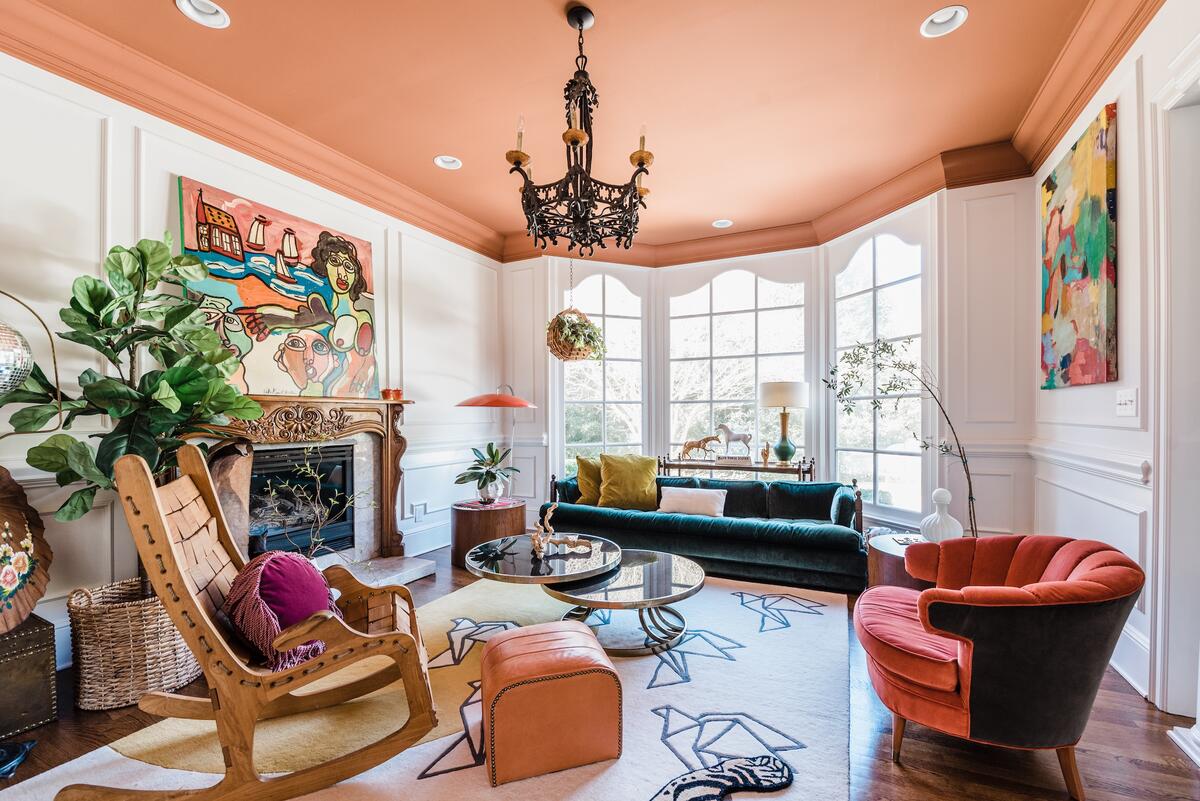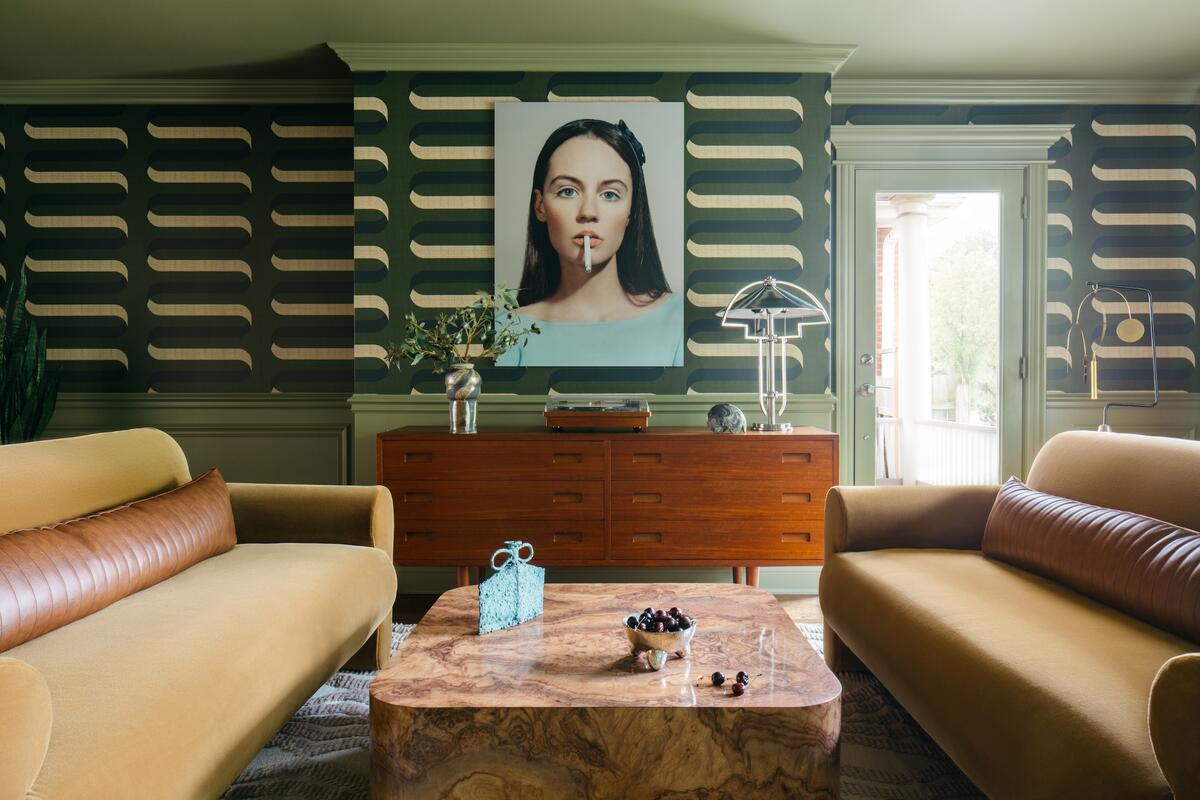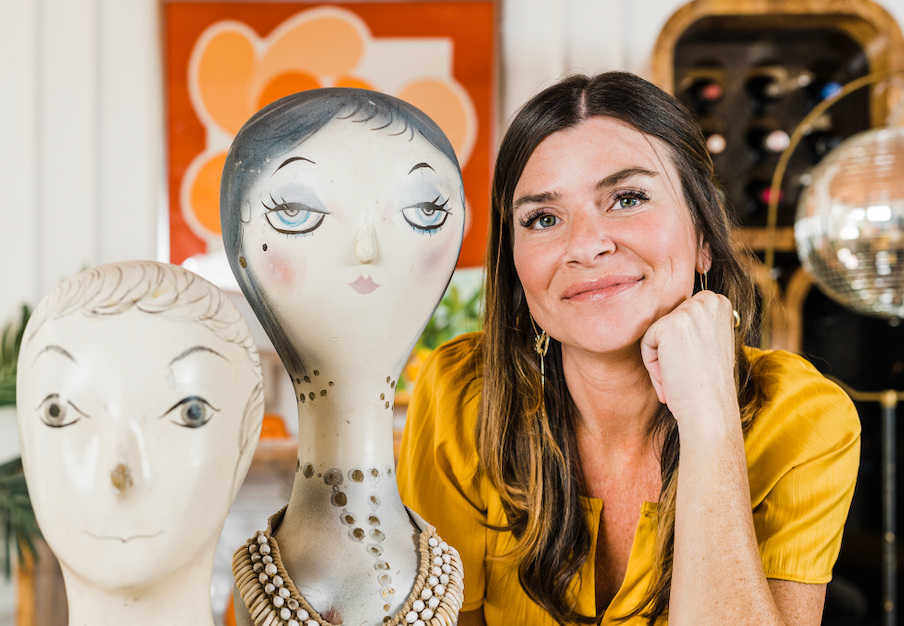In Ask an Influencer, Business of Home explores the creator economy. This week, we spoke with Charlotte, North Carolina–based interior designer and artist Natalie Papier (@home_ec_op).
In her youth, the creative possibilities felt endless for Natalie Papier. Growing up in a charming Victorian home in the Chicago suburbs, her father—an artist turned carpenter—was constantly at work tuning up the house, while her mother kept a steady stream of thrifted treasures coming through the door. It seemed like Papier would continue that tradition after she secured a scholarship to attend art school. Upon graduation, however, her dreams of a future filled with artistic pursuits took a turn.
“It didn’t look like I wanted it to,” says Papier. “If you’re in the art world and live in a teeny, tiny town, it’s really hard to find a job in the arts.”
Instead, she ended up working at a bank, and eventually moved into Chicago to work in accounting. Before long, she got married, had two kids, and became a stay-at-home mom—but around that time, a shift began to occur. She and her husband bought a Victorian home, and suddenly a new creative canvas emerged.
Between her kids’ naps and preschool pickups, Papier took on small creative projects around the house—painting a ceiling here, rearranging some furniture there. In order to tap into a community that shared her passion for design, she began posting on Instagram. From there, her popularity snowballed: Her audience quickly grew, leading to local design projects, which in turn caught the attention of publications like Design*Sponge and Apartment Therapy.
Today, Papier’s success has reached new heights—along with netting her an audience of 178,000 followers on Instagram, she credits her social media prowess with launching her design firm, Home Ec., and landing her projects like the Magnolia Network show Artfully Designed and her upcoming book, Start With the Art, set to debut later this month.
Ahead, Papier shares how she used Instagram to put herself on the path toward product licensing, why she focuses on audience engagement over algorithm updates, and how a unique design project turned into the concept for her TV show.
Laying the groundwork
On social media, Papier says, what you put into the platform is what you’re going to get back. If you’re updating your feed with recent portfolio photos, you’re likely to attract potential clients. If you’re interacting with fellow designers, you’re sure to build a community. If you want to partner with brands or explore product licensing—you have to let them know you’re a fan, and come prepared with proof to back it up.

“I put in a lot of hard work on the design side and community side, and those opportunities found me, but I was also really engaged with brands and making sure I was tagging them and commenting on things I loved,” says Papier. “It’s really good to connect with the brands at a level that lets them know that you really love their product.”
For example, when Papier found Mitchell Black’s Stalking Tiger wallpaper early on in her design career, she knew it would become a staple of future projects—plus, she felt a connection with the fellow Chicago-based, women-owned brand. Over the years, she continued to tag the brand in posts of projects where the pattern featured, and in 2023, the company approached her to create her own wallpaper collection.
“It’s really hard to get recognized when you’re first starting out,” says Papier. “But if you’re building the portfolio, you’re tagging the brands, you’re connecting with the brands and letting them know you really love their stuff, there are so many opportunities that can come from that.”
As your social media profile grows—and brand partnerships and media opportunities along with it—Papier recommends seeking out the help of an agent or manager to help with negotiating contracts for larger deals. She began working with her manager around the same time she signed on to star in Artfully Designed, and soon began to use his services to navigate social media opportunities.
“I think we all have a little bit of this imposter syndrome feeling, where you don’t know your own worth, and you don’t know if the brand is going to pass you up if you’re asking for too much,” says Papier. “My manager came back with numbers that I wouldn’t have ever felt comfortable asking.”
Putting people first
When Papier initially began posting creative projects that she was undertaking around her own home, she wasn’t sure how they would turn out—she hadn’t worked in a creative sector in a while and had no formal design training. Instead of hoping for a picture-perfect finished product that would land on Instagram Explore, she took a different tact: building a connection with her audience by expressing her own uncertainty.
“I was being really realistic in my captions, like, ‘I don’t know how this is going to turn out, but it’s just paint, and I’m just going to try it,’” says Papier. “I was really vulnerable and authentic, and I think that was what people connected with the most.”

The approach ties into Papier’s overall content strategy, which involves spending more time and effort on audience engagement—responding to messages and comments, for example—and less on trying to harness Instagram's algorithm by constantly recalibrating the kind of content she produces. Instead of trying to unlock growth by obsessing over one format, she aims to post a mix of content (including Reels, carousel posts and single photos).
“Things are changing every day. As long as you’re doing something that feels good to you and you’re happy with the growth that comes out of that, I think that’s your best bet,” says Papier. “Engaging in your community is the best way to grow. … If you have an audience commenting on your stuff, then comment back—pay that love forward. That’s how social media goes around.”
From one screen to another
Earlier in Papier’s social media days, she experienced her first brush with potential design TV stardom. A production company noticed her work and reached out to craft a pitch for HGTV. Unfortunately, the network turned the idea down, and Papier returned to her usual schedule of design work and content creation.
But she didn’t let the missed opportunity shake her creative confidence. She continued to grow her online audience, and eventually completed a unique project (which she documented on Instagram, of course) that involved inviting two other artists to contribute murals and installations to a home project she was working on in California.
“That same production company reached out, and they said, ‘OK, that’s your TV show concept,’” says Papier. “And that’s when it was picked up.”
Today, she is two seasons into Artfully Designed, which stars her and the two fellow artists featured in the original project as they execute art-focused home design schemes. She largely credits her experimenting with storytelling on social media as the driving force behind the series.
“Part of the thing with social media is that you can put a pretty picture up, but I am more interested in the story behind it—give me something to learn from this,” she says. “It’s an opportunity to tell you the why or how behind it.”
The biggest hurdle, she says, can be gathering the courage to put yourself and your ideas out there. “You have to make yourself known, and it can be very uncomfortable to do so, but you don’t have to have a million followers either,” says Papier. “If you’re just staying authentic to your brand, or you have an interesting look, I think those opportunities come and find you at the right time.”





























